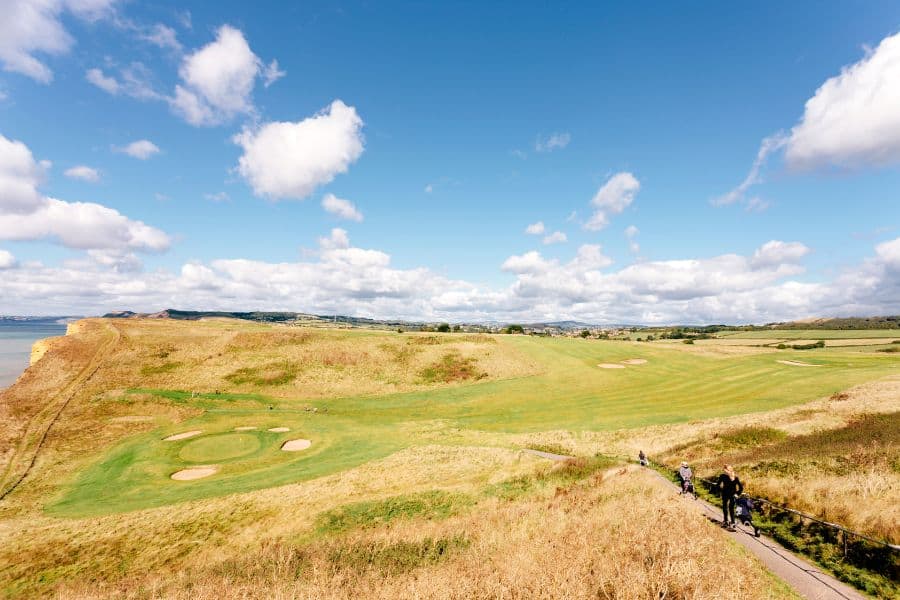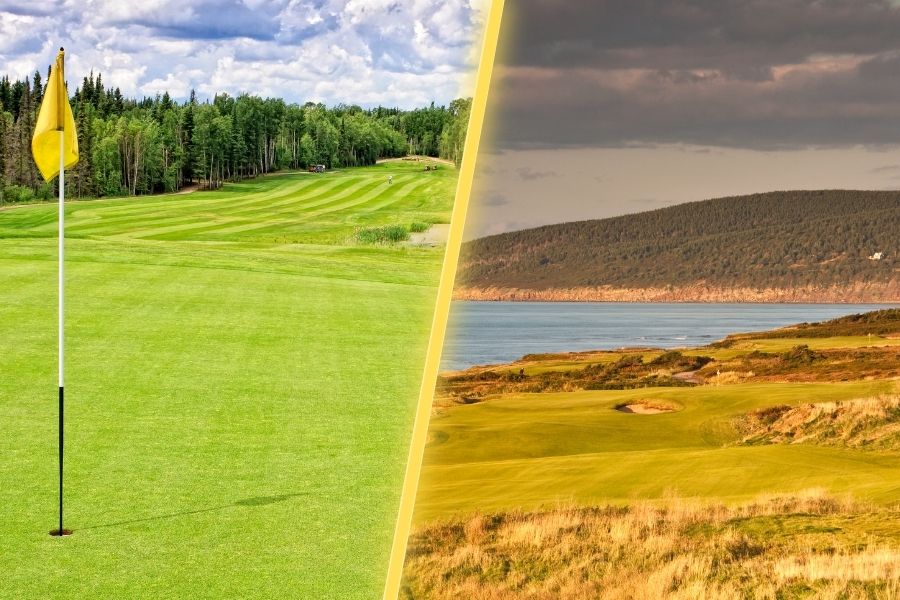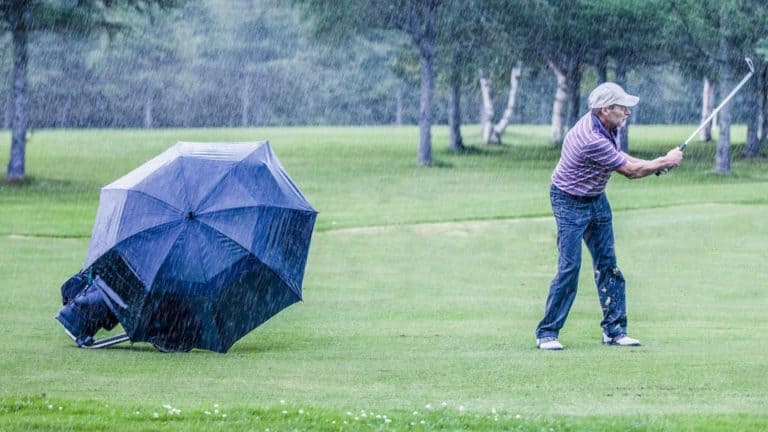What Is A Links Golf Course?: Definition, Origin, And Types

Playing golf on a links golf course is considered by many to be the purest form of golf. Here, we analyze the historical importance of the links course and why it still continues to be loved by golfers.
Links golf courses are a type of course often situated near the coast, typically a narrow stretch that serves as a bridge between ocean and inward areas.
With their natural terrain, fast greens and undulating surfaces, these courses offer a more challenging golf experience.
Here is everything you need to know about the “Links course” and its significance in the golf world.
What is a Links golf course?
‘The Links’ is a term that comes from the word ‘hlincs’ and originates in Britain. It describes the typical strip of undulating and sandy terrain connecting the sea with adjacent farmland.
The word ‘hlincs,’ which originally meant ridges/ rising ground, was used to refer to Scottish courses with sandy soil, sweeping dunes, and windswept grass.
Since this terrain was often neglected and unvisited, it became the perfect field for play on Scotland’s east coast during the 15th and 16th centuries. This is where they tried out their new game involving a stick and ball.
Consequently, golf courses that abide by the “Links-style” are known as “Links.” These courses comprise a sandy foundation, shorter grass, a shoreline nearby, and an obstacle arrangement, including slopes.
Characteristics of a Links course
As mentioned earlier, a links course is known for its difficulty, remoteness, and close proximity to the sea.
Links courses offer a variety of challenges due to the terrain and the elements.
Generally, a Links course has barely any vegetation apart from the tall sea grass and gorse. The golf holes on such courses are designed using the surrounding natural terrain.
Players must navigate their way through a mix of natural hazards, sand dunes, and bunkers while dealing with the wind.
The design of the holes on a Links course is unique, with the first nine winding outward and away from the clubhouse. While the remaining nine bring you back.
Where to Play Links Golf?
There are several true Links courses found in the UK, Ireland, and around the North sea coast of Europe.
The oldest course at St.Andrews Links in Fife, Scotland, is the most prestigious of all Links courses. It is known to have evidence of playing golf that tracks back to 1552.
In the USA, Pebble Beach golf Links are classified as Links courses and are one of the most famous Link courses that host the PGA tour.
History of the links course
The origin of golf itself has been traced back to the late 1400s. Scotland is known to be the “home of golf.” It was also the place where links golf courses were first founded.
Golf originated on the coastal regions known as links land, which were formerly disregarded stretches of territory between the beaches and inland farmland.
Scotland during the middle ages was predominantly an agricultural society, with fields of barren land and sparse vegetation.
Sheep were known to roam these lands as they grazed on various types of grass that grew in sandy soil. Early golfers were mostly shepherds who must have used sticks to hit rocks into the holes to challenge one another as to who could score a hole within minimal attempts.
Over time golf evolved, and so did the courses. The courses were further refined, with animals aiding the course design. Sheep burrows became pot bunkers, and winds blew sand that gave the course its shape.
Other types of golf courses
Golf courses around the world come in five varieties: Links, parkland, desert, heathland, and sandbelt, all with such distinct characteristics.
While these names may be well-known among seasoned players, those just starting out could benefit from learning about each individual type’s special traits.
1. Parkland golf courses
Most golf courses in the world are called parkland courses, meaning courses not built on the Links land but rather on land consisting of fields with trees.
On the contrary, most modern-day Links-style courses are built on parkland courses that have removed the trees and built up artificial dunes.
As the game of golf progressed, it moved away from its coastal roots and ventured inland. This transition led to a new type of course that was greener, with an abundance of trees throughout.
These lusher landscapes created more diverse, interesting courses for players around the world to enjoy. As these courses resembled parks, they became known as parkland golf courses.
One of the most famous parkland courses in the world is Augusta National.
Links courses typically hold a more natural landscape and setting. In contrast, a Parkland golf course is one that has been carefully built and constructed by a course architect.
A parkland course is renowned for its flat, smooth fairways, making it easier to hit the ball accurately. These fairways are far more forgiving than their rolling counterparts found on a Links course.
2. Desert golf courses
In regions with a drier climate, desert courses have become increasingly common. They are found in areas with natural deserts constructed amongst the sand dunes.
In this type of course, the grass is only found on the fairways, tee boxes, and putting greens.
Desert golf courses are mostly located in Southwest America and the Middle East.
3. Heathland golf courses
Heath is a vast land with low-growing vegetation like gorse, coarse grasses, and heather.
The terrain is ideal for golf as its land is mostly sandy but firm. These courses are carefully manicured but require minimal maintenance.
Most of the Heathland courses are found in Britain. Sunningdale Golf Club, Woodland Spa, Alwoodley Golf Club, and Walton Heath are some of the most well-recognized Heathland golf courses.
4. Sandbelt golf courses
Melbourne, Australia’s sandbelt region is renowned worldwide for its exclusive group of eight golf courses. This is what Sandbelt Golf stands for.
They are built on loamy soil and rolling hills/ undulating terrain.
These courses are constructed to have fast greens and steep-edged bunkers.
Moreover, due to the temperate climate of this region, the game can be played throughout the year.
Royal Melbourne is one of the most recognized Sandbelt golf courses that has hosted several championships.
What Makes A Links So Special?
Links golf is the oldest of the three primary styles of golf courses – dating back to the origins of the sport. This makes it a tougher challenge for players, whether due to weather conditions or due to its unforgiving layout. These external elements make links courses an ultimate test of a golfer’s skill and something far more difficult than desert or parkland courses.
Tips to consider while playing over Links course
Here are some helpful tips if you’re ever playing on a blustery links course:
- Make the wind work for you, even though it might seem challenging.
- Tee your ball low and line up in the middle of your stance.
- Play low shots – punch it or else it’ll come right back to you.
- Be prepared to do some distance putting, even off the green at times.
- Utilize ‘bump and run’ shots when the ground allows it – this can help with control.
- Hybrid clubs often help with more control, so keep them in mind!
- When your ball is in the bunker, play it safe – no need to go all out!
- Consider choosing golf balls that perform better in the wind for added advantage.
What is the difference between links golf courses and regular course?

Links golf courses offer players an entirely different experience from regular courses. Unlike the latter, which is crafted by man, link courses preserve the classic lay of the land. Playing here invokes the spirit of how golf was played in its early days – one that relies on a combination of skill, creativity, luck, and risk-taking to be successful, even if a player is already familiar with the course.
Are links golf course and a links-style golf course the same?
Many golf courses add elements of links golf to their courses, taking inspiration from the traditional style.
A true Links course is created on a stretch of undulating land next to the sea and can be natural or man-made.
On the other hand, links-style golf courses contain some characteristics inspired by traditional golf courses but may not necessarily be located by the sea.
Thus a links golf course is not the same as a links-style course.
Is Augusta a Links Course?
Augusta National was inspired by the Old Course, a well-known links course. Its founders, Mackenzie, and Bobby Jones took their cues from the Old Course when designing Augusta National – making it the perfect example of a classic links course.
Who Plays the Best on Links Golf Courses?
Jordan Spieth holds the record as the best player on links golf courses. Out of more than 300 players, his rate is higher than anyone else’s – a testament to his skill and mastery of the game.
Conclusion
Playing Links golf is a unique experience that offers its own set of challenges and rewards. It is the oldest form of golf course, originating from the coastal lands in Scotland. As the game has evolved, different types of courses have emerged and become popular around the world.








